Spontaneous Scalarization in Scalar-Tensor Theories with Conformal Symmetry as an Attractor
Abstract
Motivated by constant-G theory, we introduce a one-parameter family of scalar-tensor theories as an extension of constant-G theory in which the conformal symmetry is a cosmological attractor. Since the model has the coupling function of negative curvature, we expect spontaneous scalarization occurs and the parameter is constrained by pulsar-timing measurements. Modeling neutron stars with realistic equation of states, we study the structure of neutron stars and calculate the effective scalar coupling with the neutron star in these theories. We find that within the parameter region where the observational constraints are satisfied, the effective scalar coupling almost coincides with that derived using the quadratic model with the same curvature. This indicates that the constraints obtained by the quadratic model will be used to limit the curvature of the coupling function universally in the future.
1 Introduction
The equivalence principle played the principal role in constructing general relativity (GR) by Einstein. The weak equivalence principle (WEP) states that the motion of a (uncharged) test body is independent of its internal structure and composition. WEP together with the local Lorentz invariance (independence of the results of nongravitational experiments from the velocity of the local Lorentz frame) and the local position invariance (the independence of the experimental results from the spacetime position) enables us to make the matter couple universally to gravity. Among various gravity theories, GR is the exception in that the equivalence principle is satisfied even for self-gravitating bodies: the strong equivalence principle (SEP).
In general scalar-tensor theories of gravity Bergmann:1968ve ; Nordtvedt:1970uv ; Wagoner:1970vr , the equation of motion of a self-gravitating massive body (at the first post-Newtonian approximation) depends on the inertial mass and the (passive) gravitational mass of the body. The ratio is given by
| (1) |
where is the gravitational self-energy of the body will2018 . This implies that the motion of a massive body depends on its internal structure, being in violation of the SEP. The coefficient in front of the gravitational self-energy is , where and are the parametrized post-Newtonian (PPN) parameters. For , the orbit of the Moon around the Earth is elongated toward the Sun (Nordtvedt effect Nordtvedt:1968qs ).111 From the lunar-laser-ranging experiment, is constrained as Hofmann:2018myc .
In GR, so that the equation of motion solely depends on the inertial mass and the velocity of its center of mass. However, even in scalar-tensor gravity, one may construct a theory with so that SEP holds. The “constant-” theory by Barker 1978ApJ…219….5B is such an example. In fact, as shown by Damour:1992we , it is the unique scalar-tensor theory which satisfies the SEP (at the first post-Newtonian approximation). Even more interestingly, the theory is cosmologically attracted toward the conformally symmetry Gerard:2006ia where the theory is scale-invariant. The conformal symmetry (and its spontaneous breaking) has been actively studied in constructing models of inflation Kallosh:2013hoa ; Kallosh:2013daa and in constructing geodesically complete cosmologies Bars:2011aa ; Bars:2013yba . Here the conformal symmetry will be restored in the future. Motivated by this remarkable property of constant- theory, we introduce a one-parameter family of scalar-tensor theories which exhibits the cosmological attraction toward conformal symmetry.
Since the curvature of the coupling function of these theories is negative, the scalar field experiences a tachyonic instability inside a compact star like a neutron star and the scalar field exhibits large deviation from its asymptotic value, a phenomenon so-called “spontaneous scalarization” Damour:1993hw , which is constrained by pulsar-timing observations.
In order to put constraints on the scalar-tensor theories from the binary pulsars, the dependence of the scalarization both on the equation of state (EOS) of a neutron star and on the coupling function (the function which determines the strength of the coupling to matter in the Einstein frame) must be taken into account. The dependence of the scalarization on the EOSs is studied in Harada:1997mr ; Novak:1998rk ; Damour:1998jk ; Shibata:2013pra ; Shao:2017gwu ; Wex:2020ald , and it is found that the threshold value of the scalarization is insensitive to EOS. Moreover, Ref.Shao:2017gwu find that there are several observational windows for the scalarization depending on the EOSs. However, the dependence on the coupling function has not been much studied and usually the quadratic model Damour:1993hw is used. Anderson:2019eay studied binary pulsar constraints on two scalar-tensor theories (the quadratic model Damour:1993hw and MO model Mendes:2016fby ) and found that the constraints in the two theories are roughly the same.
We extend these previous studies by using our coupling function in light of new and updated pulsar data. We find that the window at is almost closed even if the dependence of the EOSs is taken into account. The coupling function used in this study deviates from a quadratic function with the same curvature for a large scalar field. However, we find that the deviation is small within the parameter region where the observational constraints are satisfied. Therefore, as far as the observational constraints on spontaneous scalarization are concerned, it is sufficient to employ the quadratic function for the coupling function.
The paper is organized as follows. In Sec. 2, we review the properties of constant-G theory and introduce the conformal attractor model, a one-parameter family of scalar-tensor theories with the cosmological attraction toward the conformal symmetry. In Sec. 3, we study the structure of neutron stars in these theories and calculate the masses of neutron stars and the effective scalar coupling with the neutron star using three EOSs and compare them with the observational constraints. We also calculate the effective scalar coupling for the quadratic model. Sec. 4 is devoted to summary. We use the units of .
2 Cosmological Conformal Attractor
2.1 and Constant- Theory
We consider scalar-tensor theories of gravity whose action in the Jordan frame is given by
| (2) |
where is the so-called Brans-Dicke scalar field, the inverse of which plays the role of the effective gravitational “constant”, is the Brans-Dicke function which determines the strength of the coupling of the scalar field to gravity (and matter), is the matter action and denotes the matter field.
We note that for , the gravity part of the action is locally conformal invariant under the following Weyl scaling222The action is still conformal invariant even if one includes a potential proportional to . However, the equation of the motion of the scalar field is not affected by such a potential as discussed in 2.2. :
| (3) |
From the post-Newtonian expansion of the theory, the effective gravitational constant and the parametrized post-Newtonian (PPN) parameters and of scalar-tensor theories are given by will2018 333We do not use the units of the present-day gravitational constant at this stage because we are interested in the cosmological evolution of .
| (4) | |||||
| (5) | |||||
| (6) |
The equation of motion of a massive body is given in Damour:1992we ; will2018 . It contains terms which depend on the gravitational self-energy, the coefficient of which is . For , the motion of massive bodies does not depend on their internal structure and hence respects SEP.
Remarkably, and are related by (see Damour:1992we for a similar relation)
| (7) |
Therefore, , for which the theory respects the SEP, implies either (GR) or . The latter is known as “constant-” theory found by Barker 1978ApJ…219….5B in which is given by
| (8) |
Note that (GR) for and that (conformal symmetry) for . The constraint on from the measurement of the time delay of the Cassini spacecraft is Bertotti:2003rm , which is satisfied for at present.
2.2 Cosmological Evolution
In order to study the dynamics of , it is useful to perform the following change of variables and moving to the so-called Einstein frame Damour:1993id ; Chiba:2013mha in which is decoupled from the gravity sector:
| (9) | |||||
| (10) |
where is the bare gravitational constant. The action (2) can be rewritten in terms of whose kinetic term is of Einstein-Hilbert form and a canonically normalized scalar field as 444 Note that our is related to the scalar field in Damour:1992we ; Damour:1993hw via .
| (11) |
From Eq. (11), the equation of motion of and are given by
| (12) | |||
| (13) |
where is the energy-momentum tensor in the Einstein frame. From Eq. (13), we find that moves according to the effective potential .555We note that the action Eq.(2) is still conformal invariant even if one includes a potential proportional to . In the Einstein frame action Eq.(11) such a potential corresponds to a constant and does not affect the evolution of the scalar field. The effective gravitational constant and the PPN parameter are written as
| (14) | |||||
| (15) |
where and denotes the value of at spatial infinity.

For constant- theory with in Eq. (8), from Eq. (9) and Eq. (10), and are given by
| (16) | |||||
| (17) |
where is assumed ( for ) and coincides with . We have fixed the integration constant so that corresponds to . The conformal symmetry () now corresponds to . In Fig. 1, is shown. The constraint by the Cassini experiment is satisfied for at present. From Eq. (13), one may see that moves toward according to the effective potential (see Fig. 1) during the matter-dominated epoch and during the dark energy-dominated epoch: The theory is thus cosmologically attracted toward the conformal symmetry Gerard:2006ia .
2.3 Conformal Attractor Model
Although the scalar-tensor theory with is unique, we may consider possible generalization of the models which exhibit cosmological attraction toward the conformal symmetry.
For example, we can consider the following generalization of the coupling function in Eq. (17):
| (18) |
where is a non-negative parameter and corresponds to constant-G theory. From Eq. (9) and Eq. (10), the corresponding and are given by
| (19) | |||||
| (20) |
The conformal symmetry now corresponds to and the shape of is similar to Eq. (17) () and we expect similar cosmological attraction toward the conformal symmetry. 666We note that a theory with a quadratic function with Damour:1993hw is also cosmologically attracted toward the conformal symmetry.
On the other hand, the effective gravitational constant defined by Eq. (4) is given by
| (21) |
and the gravitational constant is no longer constant. PPN parameters and and are given from Eq.(5) and Eq. (6) by
| (22) | |||||
| (23) | |||||
| (24) |
In terms of , can be rewritten in a suggestive form:
| (25) |
Therefore, although is no longer vanishing as long as , it is suppressed by . From the bound by Cassini Bertotti:2003rm , the constraint on from the lunar-laser-ranging experiment, Hofmann:2018myc , is satisfied for .
3 Spontaneous Scalarization in Conformal Attractor Model
The curvature of the coupling function Eq. (18) at is negative. For with negative curvature, the scalar field experiences a tachyonic instability inside a compact star like a neutron star and exhibits a large deviation from its asymptotic value, a phenomenon so-called “spontaneous scalarization” Damour:1993hw . From the observation of the pulsar-timings of several neutron star-white dwarf binaries, such a phenomenon has been constrained Antoniadis:2013pzd ; Shao:2017gwu .
Assuming a quadratic form of , is constrained as 777Note that since in Damour:1993hw corresponds to , in corresponds to . Although the coupling function in Eq. (18) is well approximated as for , the scalar field acquires a large value when the theory exhibits spontaneous scalarization and higher order terms in the Taylor expansion of may not be negligible and it is not clear whether the limit on from the quadratic model may apply here.
Hence, in this section, we study spontaneous scalarization for the conformal attractor model Eq. (18) and compare it with the quadratic model.
3.1 TOV equation
We study the spherically symmetric static solutions generated by perfect fluid neutron stars in scalar-tensor theories. The metric in the Einstein frame is assumed to be of the form
| (26) |
The perfect fluid energy-momentum in the Jordan frame is
| (27) |
and is related to the energy-momentum tensor in the Einstein frame by . The equation of motion Eq. (12) and Eq. (13) become
| (28) | |||||
| (29) | |||||
| (30) | |||||
| (31) |
where the prime denotes a derivative with respect to .
With the coupling function Eq. (18), given the initial conditions at , we numerically integrate these equation outward using a 4th-order Runge-Kutta method. The pressure goes to zero at the surface of star, and beyond that only the metric and scalar equations with vanishing and are necessary. Specifically, we set and to zero if is less than (with and ) well below neutron drip and integrate Eq. (28) Eq. (30) further outward. The regularity at requires . We can freely specify and . But in order to satisfy the bound by the Cassini satellite experiment , from Eq. (15) the asymptotic value should satisfy . Considering the limit on and in order to put conservative constraints on the theory, we require at large . Hence, for a given , a particular value of can satisfy this condition. We employ the shooting method to find .
3.2 Equation of State
As an equation of state (EOS), we adopt piecewise-polytropic parametrizations for the nuclear EOS by Read et al. Read:2008iy for APR4 Akmal:1998cf and H4 Glendenning:1991es ; Lackey:2005tk and MS1 Mueller:1996pm EOSs. APR4 (variational method) and MS1 (relativistic mean-field theory) are EOSs for nuclear matter composed of neutrons, protons, electrons, and muons, whereas H4 (relativistic mean-field theory) includes the effect of hyperons in addition.
A piecewise polytropic EOS consists of several polytropic EOSs
| (32) |
where is the rest-mass density. From the continuity of the pressure at determines at the next interval as . The energy density is determined by the first law of thermodynamics, as
| (33) |
where is an integration constant given by
| (34) |
from the continuity of the energy density at .
In the four-parameter model of Read:2008iy , the EOS at low densities (crust EOS) is fixed to the EOS of Douchin and Haensel Douchin:2001sv and is matched to a polytrope with adiabatic exponent . At a fixed rest-mass density888In terms of the nuclear saturation density , . and pressure , the EOS is joined continuously to a second polytrope with . Finally, at , the EOS is joined to a third polytrope with . Further details are described in Read:2008iy .
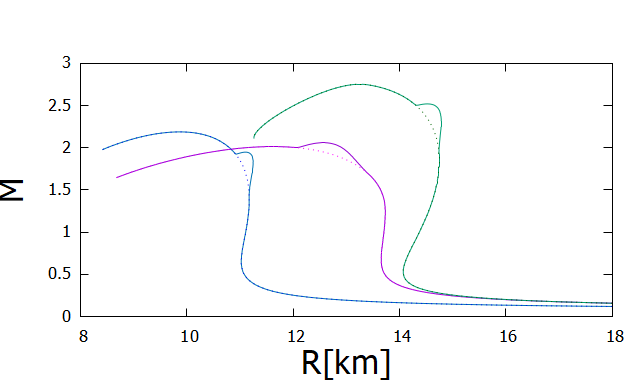
In Fig. 2, we show the mass-radius relation for three EOSs for the conformal attractor model Eq. (18) with (solid) and GR (dotted). The physical radius of a neutron star is defined in terms of the surface of the star by . Among three EOSs, MS1 is the stiffest (large ) EOS and the radius of a neutron star is large ( in GR), while APR4 is a soft EOS and the radius of a neutron star is small (). In fact, a strong correlation between the pressure at around the nuclear saturation density and the radius of neutron stars has been found Lattimer:2000nx . H4 is in between the two EOSs. On the other hand, the maximum mass of a neutron star (in GR) is the largest for MS1 (), while the smallest for H4 () but is still compatible with the most massive pulsar () measured by NANOGrav:2019jur ; Fonseca:2021wxt .
We also show the radial profile of the energy density in unit of for APR4 EOS in the left of Fig. 3 and the radial profile of the scalar field in the right.
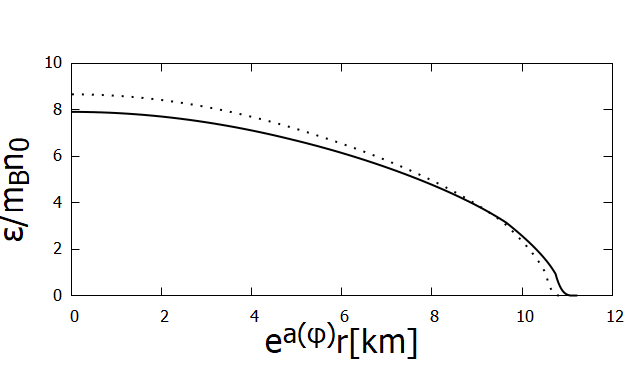
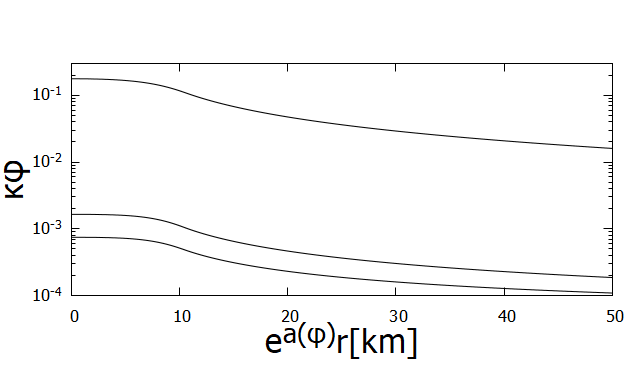
For each EOS, we compute the total gravitational (ADM) mass of the neutron star which is easily read off from the asymptotic behavior of at infinity as . Also, from the asymptotic behavior of , , we compute the scalar charge of the neutron star. The effective scalar coupling introduced in Damour:1992we ; Damour:1993hw is written in terms of and as (note again that our is related to the scalar field in Damour:1992we ; Damour:1993hw via )
| (35) |
3.3 Pulsar Constraints
| Pulsar | Orbital period (d) | Companion mass | Pulsar mass | ||
|---|---|---|---|---|---|
| J0348+0432 | 0.102424062722(7) | -0.273(45) | 0.172(3) | 2.01(4) | |
| J1738+0333 | 0.3547907398724(13) | -0.0170(31) | 0.181() | 1.46() | |
| J1012+5307 | 0.60467271355(3) | -0.061(4) | 0.165(15) | 1.72(16) | |
| J1713+0747 | 67.8251299228(5) | -0.34(15) | 0.290(11) | 1.33(10) | |
| J2222-0137 | 2.44576437(2) | -0.2509(76) | 1.319(4) | 1.831(10) | |
| J1909-3744 | 1.533449474305(5) | -0.51087(13) | 0.209(1) | 1.492(14) |
We consider the following 6 NS-WD binaries: PSRs J0348+0432Antoniadis:2013pzd , J1738+03332012MNRAS.423.3328F , J1012+53072009MNRAS.400..805L ; 2020MNRAS.494.4031M ; 2020ApJ…896…85D , J1713+07472019MNRAS.482.3249Z , and J2222-01372017ApJ…844..128C ; Guo:2021bqa , J1909-37442020MNRAS.499.2276L .
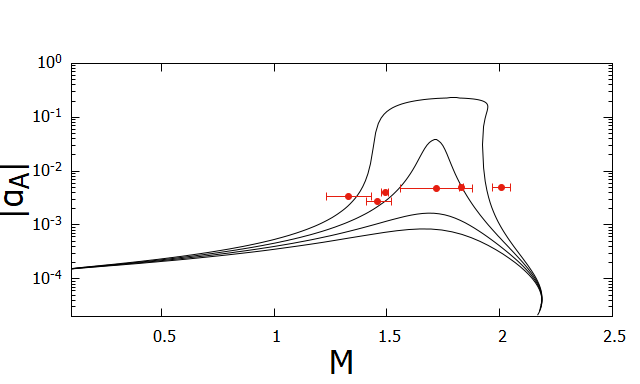
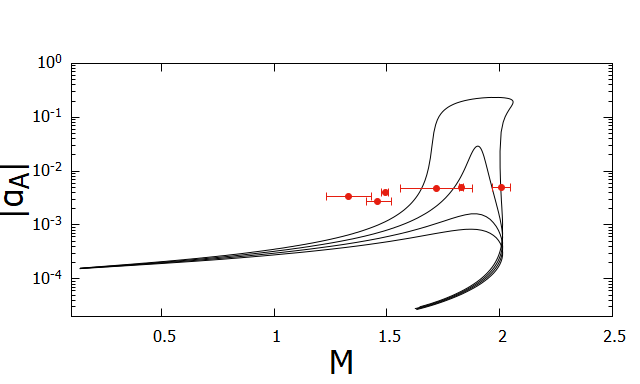
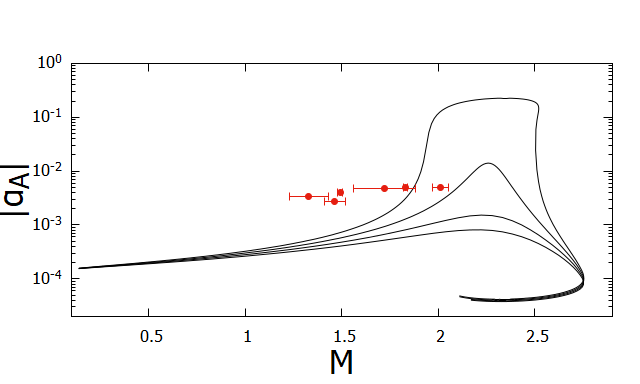
For PSR J1012+5307, the limit on the scalar coupling from the absence of the dipole radiation is recently improved in 2020ApJ…896…85D by the precise measurement of the distance by VLBI. Moreover, the mass of the neutron star is determined recently due to an estimate of the mass of the white dwarf companion using binary evolution models 2020MNRAS.494.4031M . For PSR J2222-0137, the limit on the scalar coupling is recently improved in Guo:2021bqa compared with 2017ApJ…844..128C by the improved analysis of VLBI data together with the extended timing data. For PSR 1713+0747, PSR J2222-0137 and PSR J1909-3744, the pulsar mass is determined from the Shapiro time-delays, while for others the pulsar mass is determined from the combination of the white dwarf mass determined from the optical spectrum and the mass ratio determined from the orbital velocity.
The measurements of the orbital decay of the binary systems are consistent with the orbital decay due to the emission of gravitational waves predicted by GR Peters:1964zz :
| (36) |
where is the orbital eccentricity, is the orbital period, is the companion (white dwarf) mass and is the ratio of the pulsar mass to the companion mass. In scalar-tensor theory, scalar waves are also emitted and contribute the orbital decay. For the binary systems, the dominant contribution comes from dipolar waves Damour:1992we :
| (37) |
where are the effective scalar coupling to white dwarf. Since the self-gravity of white dwarf is small, is no different from its asymptotic value: . The measurements of constrain the dipole contribution, hence . The parameters of six NS-WD binaries and the limits on are shown in Table 1.
In Fig. 4, as a function of the gravitational mass of the neutron stars for three EOSs together with the 2 limits on from the pulsar-timings are shown. We find that spontaneous scalarization occurs if and is constrained as irrespective of EOSs. 999The weak dependence of the onset of the scalarization on the EOS was found in Harada:1997mr ; Novak:1998rk . However, more detailed constraints on depend on the EOS: is constrained to be for APR4 and H4, while is allowed for MS1. We may place a conservative limit on to be . Although there exist small windows for the scalarization at for H4 and at for MS1 Shao:2017gwu , a “window at ” Shao:2017gwu is now closed with the inclusion of PSR J1012+5307 and PSR J2222-0137.
3.4 Choice of Coupling Function

So far, the effective scalar coupling is computed for the coupling function Eq. (18). However, most frequently studied gravity theory is the so-called DEF theory Damour:1993hw based on the quadratic coupling function :
| (38) |
Eq. (18) can be expanded as for , hence corresponds to in the quadratic model. Note that since in Damour:1993hw corresponds to , in corresponds to .
Although the coupling function in Eq. (18) is well approximated as as long as (see Fig. 5), the scalar field may acquire a large value when the theory exhibits spontaneous scalarization and the scalar field can experience a wider portion of the coupling function.
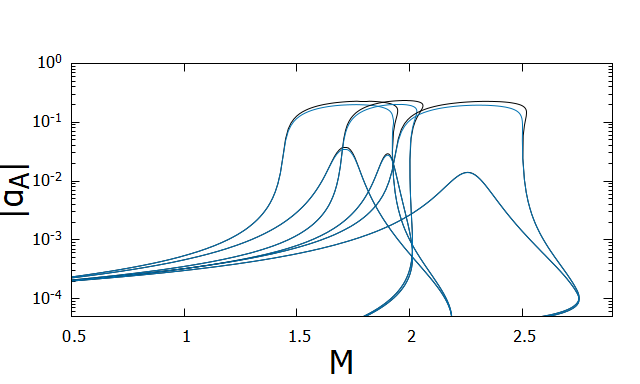
However, as shown in Fig. 6, even for , the difference of between the two coupling functions is very small. For , two s almost coincide. In fact, as shown in Fig. 7, the maximum value of the scalar field () is at most even for and higher order terms in the Taylor expansion of is negligible. Similar results are obtained by Anderson:2019eay from the comparison of the quadratic model and MO model Mendes:2016fby .
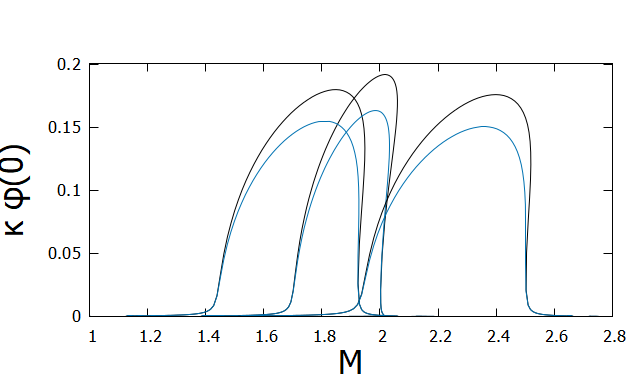
This behavior can be understood from the stability analysis of neutron stars in scalar-tensor theories Harada:1997mr ; Harada:1998ge . Spontaneous scalarization is triggered by a tachyonic instability of the scalar field of a general relativistic star. From the linear stability analysis of neutron stars, the threshold value of the curvature of the coupling function is found to be insensitive to EOSs Harada:1997mr . In the linear analysis, only the quadratic term in is relevant and possible higher order terms are not important in the analysis. Moreover, using the catastrophe theory, it is shown that the onset of spontaneous scalarization in the quadratic coupling function corresponds to cusp catastrophe Harada:1998ge which is structurally stable, i.e. the theory is stable against adding higher order terms in the coupling function. Therefore, we expect that the structure of the theory near the onset of the scalarization is described by the quadratic coupling function universally.
Since pulsar data already disfavor , we thus conclude that as far as the observational constraints on spontaneous scalarization are concerned, it is sufficient to employ the quadratic function for the coupling function.
3.5 Comment on the Cosmological Evolution
Finally we comment on the cosmological evolution of which defines its asymptotic value .
As we have seen in 2.2, the conformal attractor model is cosmologically attracted toward the conformal symmetry , in vast disagreement with the solar system experiments. Therefore, similar to the quadratic function with negative curvature, a severe fine-tuning of the initial conditions is required to satisfy the solar system constraints todaySampson:2014qqa .
One obvious and the simplest possibility to avoid this problem is to introduce a mass term for (in the Einstein frame)Chen:2015zmx ; Ramazanoglu:2016kul ; dePireySaintAlby:2017lwc . Massive scalar-tensor theories with mass of may both exhibit spontaneous scalarization (upper bound) and cosmological attraction toward GR in the matter-dominated era (lower bound). According to Ramazanoglu:2016kul , the effective scalar coupling of a neutron star is not different from that of a massless theory if but is much suppressed for .101010 may be required for the success of the big-bang nucleosynthesis dePireySaintAlby:2017lwc . If this is the case, the structure of neutron stars would be almost the same as that of a massless theory.
4 Summary
Motivated by constant-G theory which respects the SEP and is cosmologically attracted toward the conformal symmetry, we introduce a one-parameter family of scalar-tensor theories which exhibit cosmological attraction toward the conformal symmetry. From the constraint on the violation of SEP by the lunar-laser-ranging experiment, the parameter is constrained to .
We have studied the structure of neutron stars in these theories for three realistic EOSs (APR4,H4,MS1). From the constraints on the effective scalar coupling from six neutron star-white dwarf binaries, the parameter is constrained to be for APR4 and H4, while for MS1. With new pulsar data a window for the scalarization at is closed, but small windows are still open at for H4 and at for MS1.
We have also compared in detail our coupling function and the quadratic model and have found that the difference of the effective scalar coupling between the two theories is very small for . Combining these results with the structural stability of the quadratic model at the onset of scalarization Harada:1998ge , we conclude that as far as the observational constraints on spontaneous scalarization are concerned, the dependence on the coupling function is small and hence we can safely employ the quadratic function as the coupling function and the constraints obtained by the quadratic model will be used to put constraints on the curvature of the coupling function universally in the future.
Acknowledgments
We would like to thank Masahide Yamaguchi for useful comments at the earlier stage of this work. This work is supported in part by Nihon University.
References
- (1) P. G. Bergmann, Comments on the scalar tensor theory, Int. J. Theor. Phys. 1 (1968) 25.
- (2) K. Nordtvedt, Jr., PostNewtonian metric for a general class of scalar tensor gravitational theories and observational consequences, Astrophys. J. 161 (1970) 1059.
- (3) R. V. Wagoner, Scalar tensor theory and gravitational waves, Phys. Rev. D1 (1970) 3209.
- (4) C. Will, Theory and experiment in gravitational physics. Cambridge University Press, Cambridge, 2 ed., 2018.
- (5) K. Nordtvedt, Equivalence Principle for Massive Bodies. 2. Theory, Phys. Rev. 169 (1968) 1017.
- (6) F. Hofmann and J. Müller, Relativistic tests with lunar laser ranging, Class. Quant. Grav. 35 (2018) 035015.
- (7) B. M. Barker, General scalar-tensor theory of gravity with constant G., Astrophys. J. 219 (1978) 5.
- (8) T. Damour and G. Esposito-Farese, Tensor multiscalar theories of gravitation, Class. Quant. Grav. 9 (1992) 2093.
- (9) J.-M. Gerard, The Strong equivalence principle from gravitational gauge structure, Class. Quant. Grav. 24 (2007) 1867 [gr-qc/0607019].
- (10) R. Kallosh and A. Linde, Universality Class in Conformal Inflation, JCAP 07 (2013) 002 [1306.5220].
- (11) R. Kallosh and A. Linde, Multi-field Conformal Cosmological Attractors, JCAP 12 (2013) 006 [1309.2015].
- (12) I. Bars, S.-H. Chen, P. J. Steinhardt and N. Turok, Antigravity and the Big Crunch/Big Bang Transition, Phys. Lett. B 715 (2012) 278 [1112.2470].
- (13) I. Bars, P. Steinhardt and N. Turok, Local Conformal Symmetry in Physics and Cosmology, Phys. Rev. D 89 (2014) 043515 [1307.1848].
- (14) T. Damour and G. Esposito-Farese, Nonperturbative strong field effects in tensor - scalar theories of gravitation, Phys. Rev. Lett. 70 (1993) 2220.
- (15) T. Harada, Stability analysis of spherically symmetric star in scalar - tensor theories of gravity, Prog. Theor. Phys. 98 (1997) 359 [gr-qc/9706014].
- (16) J. Novak, Neutron star transition to strong scalar field state in tensor scalar gravity, Phys. Rev. D 58 (1998) 064019 [gr-qc/9806022].
- (17) T. Damour and G. Esposito-Farese, Gravitational wave versus binary - pulsar tests of strong field gravity, Phys. Rev. D 58 (1998) 042001 [gr-qc/9803031].
- (18) M. Shibata, K. Taniguchi, H. Okawa and A. Buonanno, Coalescence of binary neutron stars in a scalar-tensor theory of gravity, Phys. Rev. D 89 (2014) 084005 [1310.0627].
- (19) L. Shao, N. Sennett, A. Buonanno, M. Kramer and N. Wex, Constraining nonperturbative strong-field effects in scalar-tensor gravity by combining pulsar timing and laser-interferometer gravitational-wave detectors, Phys. Rev. X 7 (2017) 041025 [1704.07561].
- (20) N. Wex and M. Kramer, Gravity Tests with Radio Pulsars, Universe 6 (2020) 156.
- (21) D. Anderson, P. Freire and N. Yunes, Binary pulsar constraints on massless scalar–tensor theories using Bayesian statistics, Class. Quant. Grav. 36 (2019) 225009 [1901.00938].
- (22) R. F. P. Mendes and N. Ortiz, Highly compact neutron stars in scalar-tensor theories of gravity: Spontaneous scalarization versus gravitational collapse, Phys. Rev. D 93 (2016) 124035 [1604.04175].
- (23) B. Bertotti, L. Iess and P. Tortora, A test of general relativity using radio links with the Cassini spacecraft, Nature 425 (2003) 374.
- (24) T. Damour and K. Nordtvedt, Tensor - scalar cosmological models and their relaxation toward general relativity, Phys. Rev. D 48 (1993) 3436.
- (25) T. Chiba and M. Yamaguchi, Conformal-Frame (In)dependence of Cosmological Observations in Scalar-Tensor Theory, JCAP 10 (2013) 040 [1308.1142].
- (26) J. Antoniadis et al., A Massive Pulsar in a Compact Relativistic Binary, Science 340 (2013) 6131 [1304.6875].
- (27) J. S. Read, B. D. Lackey, B. J. Owen and J. L. Friedman, Constraints on a phenomenologically parameterized neutron-star equation of state, Phys. Rev. D 79 (2009) 124032 [0812.2163].
- (28) A. Akmal, V. R. Pandharipande and D. G. Ravenhall, The Equation of state of nucleon matter and neutron star structure, Phys. Rev. C 58 (1998) 1804 [nucl-th/9804027].
- (29) N. K. Glendenning and S. A. Moszkowski, Reconciliation of neutron star masses and binding of the lambda in hypernuclei, Phys. Rev. Lett. 67 (1991) 2414.
- (30) B. D. Lackey, M. Nayyar and B. J. Owen, Observational constraints on hyperons in neutron stars, Phys. Rev. D 73 (2006) 024021 [astro-ph/0507312].
- (31) H. Mueller and B. D. Serot, Relativistic mean field theory and the high density nuclear equation of state, Nucl. Phys. A 606 (1996) 508 [nucl-th/9603037].
- (32) F. Douchin and P. Haensel, A unified equation of state of dense matter and neutron star structure, Astron. Astrophys. 380 (2001) 151 [astro-ph/0111092].
- (33) J. M. Lattimer and M. Prakash, Neutron star structure and the equation of state, Astrophys. J. 550 (2001) 426 [astro-ph/0002232].
- (34) NANOGrav collaboration, Relativistic Shapiro delay measurements of an extremely massive millisecond pulsar, Nature Astron. 4 (2019) 72 [1904.06759].
- (35) E. Fonseca et al., Refined Mass and Geometric Measurements of the High-mass PSR J0740+6620, Astrophys. J. Lett. 915 (2021) L12 [2104.00880].
- (36) P. C. C. Freire, N. Wex, G. Esposito-Farèse, J. P. W. Verbiest, M. Bailes, B. A. Jacoby et al., The relativistic pulsar-white dwarf binary PSR J1738+0333 - II. The most stringent test of scalar-tensor gravity, MNRAS 423 (2012) 3328 [1205.1450].
- (37) K. Lazaridis, N. Wex, A. Jessner, M. Kramer, B. W. Stappers, G. H. Janssen et al., Generic tests of the existence of the gravitational dipole radiation and the variation of the gravitational constant, MNRAS 400 (2009) 805 [0908.0285].
- (38) D. Mata Sánchez, A. G. Istrate, M. H. van Kerkwijk, R. P. Breton and D. L. Kaplan, PSR J1012+5307: a millisecond pulsar with an extremely low-mass white dwarf companion, MNRAS 494 (2020) 4031 [2004.02901].
- (39) H. Ding, A. T. Deller, P. Freire, D. L. Kaplan, T. J. W. Lazio, R. Shannon et al., Very Long Baseline Astrometry of PSR J1012+5307 and its Implications on Alternative Theories of Gravity, ApJ 896 (2020) 85 [2004.14668].
- (40) W. W. Zhu et al., Tests of Gravitational Symmetries with Pulsar Binary J1713+0747, Mon. Not. Roy. Astron. Soc. 482 (2019) 3249 [1802.09206].
- (41) I. Cognard, P. C. C. Freire, L. Guillemot, G. Theureau, T. M. Tauris, N. Wex et al., A Massive-born Neutron Star with a Massive White Dwarf Companion, ApJ 844 (2017) 128 [1706.08060].
- (42) Y. J. Guo et al., PSR J2222–0137. I. Improved physical parameters for the system, Astron. Astrophys. 654 (2021) A16 [2107.09474].
- (43) K. Liu, L. Guillemot, A. G. Istrate, L. Shao, T. M. Tauris, N. Wex et al., A revisit of PSR J1909-3744 with 15-yr high-precision timing, MNRAS 499 (2020) 2276 [2009.12544].
- (44) P. C. Peters, Gravitational Radiation and the Motion of Two Point Masses, Phys. Rev. 136 (1964) B1224.
- (45) T. Harada, Neutron stars in scalar tensor theories of gravity and catastrophe theory, Phys. Rev. D 57 (1998) 4802 [gr-qc/9801049].
- (46) L. Sampson, N. Yunes, N. Cornish, M. Ponce, E. Barausse, A. Klein et al., Projected Constraints on Scalarization with Gravitational Waves from Neutron Star Binaries, Phys. Rev. D 90 (2014) 124091 [1407.7038].
- (47) P. Chen, T. Suyama and J. Yokoyama, Spontaneous scalarization: asymmetron as dark matter, Phys. Rev. D 92 (2015) 124016 [1508.01384].
- (48) F. M. Ramazanoğlu and F. Pretorius, Spontaneous Scalarization with Massive Fields, Phys. Rev. D 93 (2016) 064005 [1601.07475].
- (49) T. A. de Pirey Saint Alby and N. Yunes, Cosmological Evolution and Solar System Consistency of Massive Scalar-Tensor Gravity, Phys. Rev. D 96 (2017) 064040 [1703.06341].